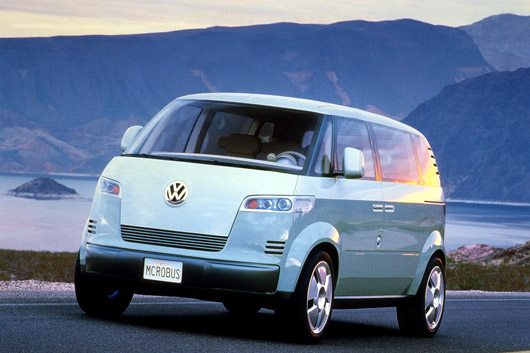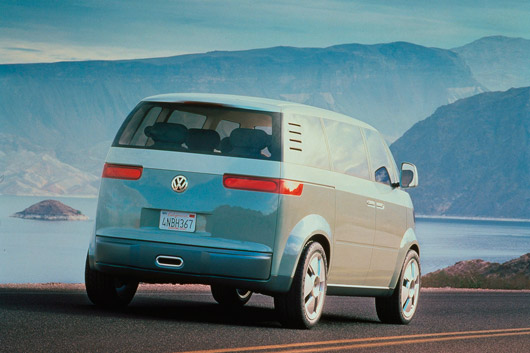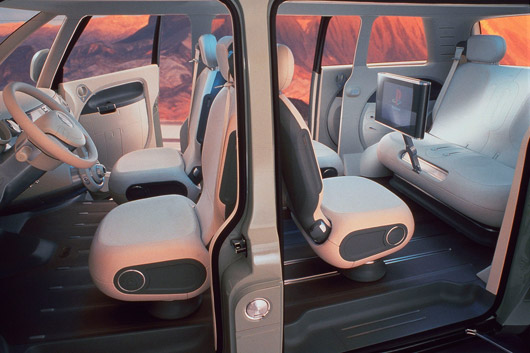The Sydney Morning Herald is reporting that a modified version of Volkswagen’s Microbus could be on the agenda, with the new Chattanooga facility the likely plant to be used for production. The Microbus was launched as a concept in 2001 (see original 2001 press release below) and was originally scheduled for 2005 production before cost cutting measures saw Volkswagen pull the pin. According to the SMH article, a German Volkswagen official claimed, “We’re looking at ways to produce the Microbus that will make it competitive in North America. At the moment there is no firm decision but, with the exchange rate the way it is, there is no way we could entertain building it in Europe.”
Read the Sydney Morning Herald article in full for more detail.
Source: Sydney Morning Herald via autoblog
Concept Car Microbus Original Design, Communicative Interior, New V6
Microbus was developed in the Volkswagen design studio in California
October 15 2001 – Volkswagen Group Australia is showing the concept car “Microbus†for the first time in the Southern hemisphere at the Sydney International Motorshow. The Australian visit follows headline-grabbing appearances at the Detroit, Geneva and Frankfurt Motorshows. The people-mover of the future was designed in the Volkswagen design studio in Simi Valley, California.
With its original design and numerous innovative ideas, the Microbus harks back to a great tradition, starting in 1950 with the first VW bus. This Volkswagen was successful worldwide and reached cult status, especially in the USA, with the name Microbus and in Australia with the name Kombi.
This design study redefines this cult with an up-to-date expression of personality and freedom.
Five metre long Microbus as Volkswagen design study
With the background of the legendary first generation of VW buses, the design of which is even today as well known and well loved as that of the Beetle and the New Beetle, the designers didn’t want to run the risk of merely copying the old bus style. The aim was to create another Volkswagen original, which was to pay homage to a great history in its own independent visionary way. The innovative Californian design team has succeeded in doing just this. No decision has been made concerning putting the Microbus into series production however the public response to its earlier show appearances has been overwhelming.
The Exterior
The Volkswagen designers created a vehicle that was a conscious new interpretation of the style elements of past VW Bus generations. The very short body overhangs are reminiscent of the first VW bus, officially called the T1.
However it differs from the classic bus in its exterior dimensions:
- The Microbus is over 4.7 metres long, and both higher and wider than 1.9 metres. That means that the design study is approximately equivalent in size to the VW Bus T4, which is sold in Australia as the Transporter/Caravelle.
The Front End
This becomes very obvious at the front end with its striking bonnet. It maintains one characteristic of the classic T1 but underneath it, as with all modern Volkswagen vehicles, is a front-mounted engine, in this case a 3.2 litre V6 engine with 170kW power output. The new interpretation becomes clearer when one looks at the connection between the bonnet, the voluminous bumper, the flat double xenon headlights and the windscreen.
The design in this area documents the exciting spectrum of the modern Volkswagen design:
- It maintains tradition, but points towards consistently new, innovative and independent characteristics at the same time.
- This independence is demonstrated on the Microbus by the particularly thin-line xenon headlights with the typical clear glass optics. They are a stylistic counter-point to the rounded headlights of the first VW Bus generation and thus look to the future.
The Side Body
The side body of the design study is characterised by the concept of the windows and an additional side window in front of the A-pillar, powerful D-pillars with integrated glass slits and large sliding doors. These doors open and close electronically at the push of a button. The emphasis on the powerful wheel arches ensures that the vehicle has a dynamic appearance. They provide the space for the specially developed 20†alloy wheels with 245/45 R 20 tires.
The Rear End
A further demonstration of the independence of Volkswagen design can be seen at the rear end of the vehicle.
The design is both clear and functional, but the emotional form language is, however, continued. The flat rear lights correspond in design to the front headlights. From this perspective, the wide track and tires have a particularly dynamic effect. As a conscious element of the design, the large VW symbol dominates the large tailgate as it does the front end.
The interior represents a new dimension for comfort…
The Interior
As soon as the doors open on the Microbus, one can see an interior, which both visually and technically shows the perspectives for the Van of tomorrow. Large lights integrated into the roof area create a friendly and light atmosphere. A particularly interesting solution was found by the development team for the floor of the interior. It is made of a semi-transparent material with a geometric pattern.
The defining feature:
- A layer of aluminium is fitted underneath this material (urethane) and this shines through, harmonising perfectly with the other interior colours.
The Instruments
A progressive concept is also characteristic of the instruments:
The dash panel base has an asymmetric design. It comes further forward near the driver, thus optimising the feeling of space. The circular instruments with an analogue tachometer and digital additional information as well as the gear stick integrated into the instrument panel are particularly striking. Using this joystick, the five speed automatic gearbox with tiptronic function can be shifted either fully automatically or manually.
The advantages of the layout of the instruments:
- The gear stick does not prevent the driver or front passenger from getting through to the other passengers while taking a break from driving.
The Seating Concept
The Microbus has three rows of seats which are covered in a high-quality nappa leather in the colours “Cotton White†(seat surfaces) and “Elm Olive†(side trims). The middle centre seats can be turned through 180 degrees and the third row has been designed as a bench seat with two individual contoured seats. A rail system makes a multi-variable layout of the two rear rows possible.
All passengers have the protection of an integral seat belt:
- The belts have an ideal and independent belt guide through points in the roof pillars.
The electrical seat adjustment has been redesigned with a new layout:
- The round switch unit is located on the outer side of the seat underneath the seat surface. The seat can be shifted up, down, to the front or back by simply pressing on the desired axis on the round button.
The Information Systems
Intelligent features such as these are characteristic of many features in the interior.
The Microbus can, for example, be trans-formed into a veritable car cinema:
- The appropriate visual images are provided by a seven-inch screen in 16:9 format in the centre console, four large monitors in the backrests of the first and second rows as well as two extendable displays between the second and third rows. The latter are located in the rear bench. When the construction is pulled out to the first stage it can be used as a conventional table in the conference layout of the two rear rows of seats. In the second stage, a display is made visible on both sides when the table is moved to a vertical position.
- A second seven-inch screen provides a view of what is behind the vehicle. The Microbus has a so-called backeye camera. Along with both the exterior mirrors, this provides a comprehensive view of what is behind the vehicle. The monitor is located in the roof in the exact position where the interior mirror would otherwise be located so that the driver does not have to change their automatic responses when driving. The system also warns the driver via spoken warnings when parking that they might be getting too close to an unwanted bump.
The technology of the Microbus is not based on any of the Volkswagens currently on offer:
- The floor assembly, for example, corresponds to that of a future vehicle generation. A further development can also be see in the compact 3.2-litre V6 engine with 320 Nm of torque.
The Colours
The colour concept “Biosphere†was developed for the design study. The two colour combination – the darker “Elm green†in the lower area and the lighter “Elm green pearl†in the upper area – document the inner values of the design study to the outside: friendly, light and communicative.
The Technical Data of the Microbus
Body
Length 4,722 mm / Width 1,909 mm / Height 1,904 mm
Wheelbase 3,000 mm / Front track 1,644 mm / Rear track 1,644 mm
Engine
Principle 3.2-litre V6 / Power output 170 kW / Torque 320 Nm
Drive / Wheels
Gearbox 5-speed automatic gearbox with tiptronic / Front wheel drive
Wheels 8.5 J x 20 / Tires 245/45 R 20



10 replies on “Volkswagen’s Microbus back from the dead?”
I’d consider this as the only people mover for our family if it were built…
Those renders remind me of ‘Cars’ for some reason…
wiw.. i’d have one if they made it. i just bought a ’05 T5 Caravelle for my twins. can i buy this prototype instead?
Michael might have a confession to make, too!
[…] been a couple of years since there was a decent rumour suggesting the Volkswagen Microbus was on the way back. But, thanks […]
i want one!!!!!!!
[…] How cool is this! The Volkswagen Bulli is an all-new Kombi concept that builds not only the model’s 60 year history, but also reignites the flame lit by the 2001 Microbus concept. […]
Bump for 2011 Bulli concept -> http://www.ausmotive.com/?p=3373
Come on VW build it and they will sell !!!!!!
Would blow the competition into submission overnight.
Hurry , gotta have it
Could I get it with Diesel power? Love it.